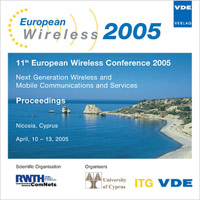A Partitioned Power and Location Aware MAC Protocol for Mobile Ad Hoc Networks
Conference: European Wireless 2005 - 11th European Wireless Conference 2005 - Next Generation wireless and Mobile Communications and Services
04/10/2006 - 04/13/2005 at Nicosia, Cyprus
Proceedings: European Wireless 2005
Pages: 7Language: englishTyp: PDF
Personal VDE Members are entitled to a 10% discount on this title
Authors:
Corbett, Derek J.; Everitt, David (Dept. of Information Technologies, Smart Internet Technology CRC, The University of Sydney, Sydney, Australia)
Abstract:
This paper proposes a novel power and location aware medium access control (MAC) protocol called LAMP (Location Aware MAC Protocol). LAMP is designed for location aware mobile ad-hoc networks (MANETs). Specifically MANETs such as Sensor Networks or Ubiquitous Computing Environments where; node location is important to the over all objective of the network and mobility is bounded. LAMP uses the concept of cellular geographical network division in order to build a distributed time division multiple access (TDMA) based schedule for transmission, reception and sleep. It allows hosts to avoid overhearing the network and instead sleep and conserve power. Power saving is a significant concern in MANETs as most mobile hosts operate with a limited amount of power available to them. LAMP trades an increase in latency for a reduction in energy consumption, while maintaining fairness in the network. The proposed MAC protocol allows hosts to reduce energy consumption by powering their radio transceivers off while still maintaining a responsive, connected and fair network. As in cellular networks this approach uses location information to partition the network into hexagonal cells. Once a host knows which cell it is in and can synchronize its clock, it can build a TDMA based transmission and reception schedule. This is a novel advancement over empirically tuned low duty cycle power conservation, as it not only intelligently minimizes power consumption but also avoids interference.


